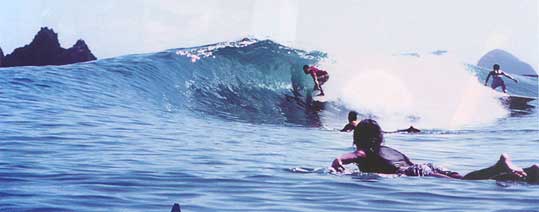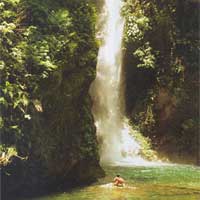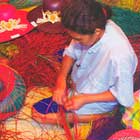Diabetease, April-May 2006
AURORA
Where Nature Finds Home
By Cesar Christopher V. Gonzales
Aurora is a treasure trove of natural and cultural attractions that promises to rejuvenate the mind, body and spirit.
A respite for the maddening grind of urban life and its many pressures is in order.

You pack your bag and shunning the usual weekend getaways, take a 45-minute SEAIR flight from Manila, to a place where the excesses of modern living take a backseat. A few minutes into your journey you are greeted by a sudden change of scenery - the industrial smog-covered wasteland gives way to lush greenery parted gracefully by a web of winding streams and rivers. You know you have finally arrived in Aurora - one of the country's best kept nature and culture hideaways.
Bordered by the provinces of Quezon on the south, Isabela on the north, Quirino and Nueva Vizcaya on the northwest and Nueve Ecija on the west, Aurora is nestled beteween the verdant forests of the Sierra Madres and the bountiful waters of the Pacific. It boasts one of the country's most extensive forest covers (approximately 70 percent of Aurora's total land area) and coastlines accented by sand, coral and pebble beaches as well as picturesque rock formations. In addition, a wide variety of inland bodies of water such as waterfalls, springs, rivers and lakes dot the province's 309,860 hectares of rich land.
You check in at Bay's Inn, one of the several beachfront facilities along Sabang Beach in Baler, Aurora's capital town. The inn is a mere five minutes away from the Central Bus Terminal and 25-minutes away from the Juan C. Angara Airport. You enter your clean, airy room equipped with all the basic amenities you need for your brief stay.

While waiting for your ginataang pako na may suso (fiddlehead ferns and snails in coconut milk) and inihaw na bigay (grilled yellow fin tuna) to cook, you watch the local surfers strut their stuff not far from the al fresco restaurant where you are seated.

Surfing is as popular as basketball in Baler, it being the home of the oldest surfing community in the country. You toy with the idea of taking surfing lessons offered at the Baywatch Tower, a watering hole of local surfers, but decide to save it for your next visit.
You have acouple of hours to explore the locality before you head to Coco Hut, a local night club across your hotel, for some drinks. You walk to the poblacion and follow the mysterious footsteps that lead you from the Church of Baler (site of the historic 'Siege of Baler' and the last Spanish outpost in the Philippines as the marker explains) to Quezon Park, the birthplace of President Manuel L. Quezon and home to the Museo de Baler. You later find out that by following the mysterious footsteps, you get a crash course on the town's colorful past.

After a quick dip at the beach the following day, you ask around where to head next. The locals whom you find exceptionally hospitable and accommodating are quick to suggest the Eco-strip that stretches from historic Dicaloyungan River, the site of the declaration of protest by local revolutionaries against Spanish rule, to Aiiao Islets, a series of rock formations set against the backdrop of the Pacific Ocean.
Together with a local guide recommended by your hotel, you visit: the Santa Isabel Church, a Spanish structure used by the townsfolk as watchtower during the pirate invasions; the Ermita Hill where you get a panoramic view of the township of Baler; Cobra Reef, the site of the annual Aurora Surfing Cup and recognized in the international surfing circuit for its perfect waves; and the curious rock formations of Dimadimalangat, Lukso-Lukso and Aiiao. You promise yourself to bring your diving gear and extra memory cards for the camera on your next visit.

After a sumptuous lunch of sinigang na buting sa aduas (local shellfish in sour broth made from aduas leaves) and chicharong kibit (sea slugs cracklings) at AMCO Resort, you travel some 15 minutes from Baler to San Luis town to visit Ditumabo Falls. You are guided by a local community leader to the mother fall, a sight to behold amid the wild foliage lining the deep cliffs surrounding it. You immerse in the cool mountain water of Ditumabo the entire afternoon. The experience more than compensates for the 4S-minute hike you are able to manage.
You soon realize there are a few more items in your itinerary. But you take it slow, not wanting to spoil your Aurora experience by taking in more than your senses can handle.
You resolve to come back. You will make time for the gold beach of Motiong and the pristine white beach and virgin mangrove forest of Casapsapan, both in the northern town of Casiguran. You will hike to Parang, a wide expanse of grassland overlooking the Pacific and Dibulo Falls in Dilasag. You will visit Bulawan Falls and the untouched coral reefs of Dinalungan; and on your way back to Baler, you will drop by the Balete Park in Maria Aurora town, home to the biggest Banyan tree in Asia.

For now, you are taking home a few things to remind you of Aurora. You will partake of the suman, the peanut butter and coco jam with your officemates over stories of your memorable adventure. You will impress the boss with export-quality sabutan hats and Casiguran Cocowine. A charming gift for the girlfriend is an exquisitely crafted sabutan bag. For your house, you bring assorted baskets made by Aurora's Dumagat artisans.
You head back to the urban jungle recharged, rejuvenated and inspired by the prospect of coming back to your newfound sanctuary.
For travel information on Aurora contact the Aurora Provincial Tourism Office at telefax (042) 209-4373 or email tourism_aurora@yahoo.com.
| << Back to index |